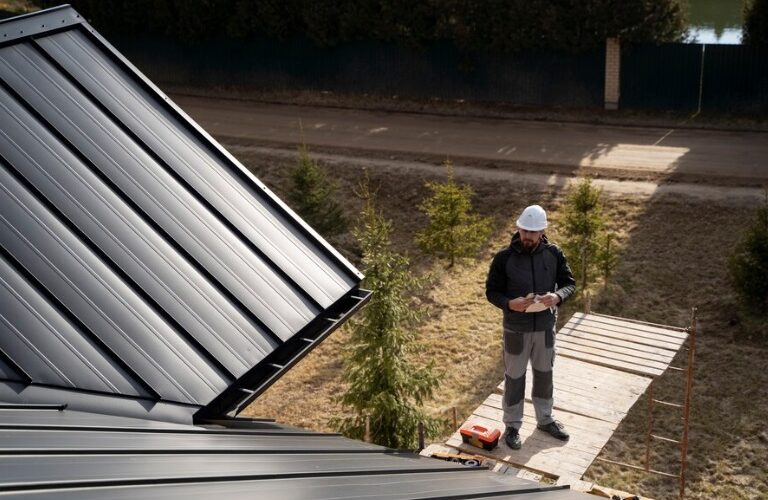Roofs play a critical role in safeguarding your home from the elements. While they are designed to withstand various weather conditions, emergencies can still arise unexpectedly. Recognizing the signs of these emergencies can save you time, money, and significant damage in the long run. Understanding the most common roof emergencies is essential for homeowners and can guide prompt action when needed.
Leaking Roofs
A leaking roof is one of the most common roof emergencies that can occur, particularly during heavy rainfall. The incessant pounding of rain can exploit even the smallest gaps or weaknesses in your roofing material. Homeowners should watch for water stains on the ceiling or walls, drips during storms, or wet insulation in the attic. These signs are often clear indicators of a failing roof. If you see any of these symptoms, it’s crucial to take action promptly to prevent water damage, which can lead to mold growth and structural issues. An alarming statistic from the National Association of Realtors shows that water damage is one of the leading causes of insurance claims. Homeowners should check for leaks at least twice a year, paying close attention to the seams, flashings, and vent areas.
Missing or Damaged Shingles
Missing or damaged shingles can lead to larger issues if not addressed swiftly. High winds, hail, or falling branches can dislodge or ruin shingles, allowing water to penetrate the roof. Homeowners should visually inspect their roofs, particularly after storms, to check for obvious damage. If you notice a cluster of missing shingles or granules in your gutters, this may be an indication to go now and give your roof immediate attention. Contacting a roofing company is advisable for the immediate assessment and repair of roof damage before it worsens
Pooling Water
Pooling water on your roof is another emergency that demands immediate attention. Generally, roofs are designed to channel water away; however, if you notice water collecting in low spots—usually due to improper drainage, debris buildup, or sagging materials—it can lead to leaks and damage. Keeping gutters and downspouts clear is crucial to maintaining roof health. Pooling water can also contribute to the deterioration of roofing materials over time, resulting in premature roof failure. Pressure systems within the roof structure can increase significantly with pooling water, leading to structural issues if left unaddressed. Noticing water pooling after rain could indicate an underlying problem that must be resolved quickly. An inspection by a qualified professional can determine whether repairs or complete replacement is necessary.
Flashing Issues
Proper flashing protects the joints and seams of a roof. It is usually made of metal and prevents water intrusion, especially around chimneys and vent pipes. If flashing wears or fits improperly, it can create entry points for water. Look for signs such as rusted flashing or gaps between the flashing and surrounding structures. If the flashing has separated or is damaged, water can seep in, posing a significant risk to the roof’s integrity. Addressing flashing issues promptly is essential. Homeowners commonly overlook flashing when inspecting their roofs. However, regular checks can ensure better roof performance and life. If flashing problems are discovered, they should be repaired as soon as possible by a professional to prevent more extensive damage.
Ice Dams
In colder climates, ice dams can become a homeowners’ headache. They form when warm air from the attic melts snow on the roof, causing water to run down and refreeze at the edges. This can lead to water backing up under shingles, resulting in leaks and damage. Signs of ice dams include icicles hanging from your gutters and water backing up into your home. Left unchecked, they can cause water damage, loosen shingles, and compromise the roof’s structure. Preventative measures include ensuring proper attic insulation and ventilation. If ice dams occur, it’s crucial to remove them carefully to prevent damage to the roofing materials.
Structural Damage
Severe storms, heavy snowfall, or falling trees can lead to structural damage that is difficult to spot without a close inspection. Homeowners should be alert for sagging roofs or visible cracks in the rafters and beams inside the attic. Such damage may compromise not just the roof but the overall safety of the home. If you suspect structural issues, it is vital to contact a qualified roofing professional to assess the situation thoroughly.
Understanding common roof emergencies is invaluable for any homeowner. By being vigilant and aware of potential issues like leaks, missing shingles, and roof rot, you can prevent costly repairs and hazards. When in doubt, consulting with a trusted roofing professional can provide peace of mind and ensure your roof continues to protect your home effectively.
